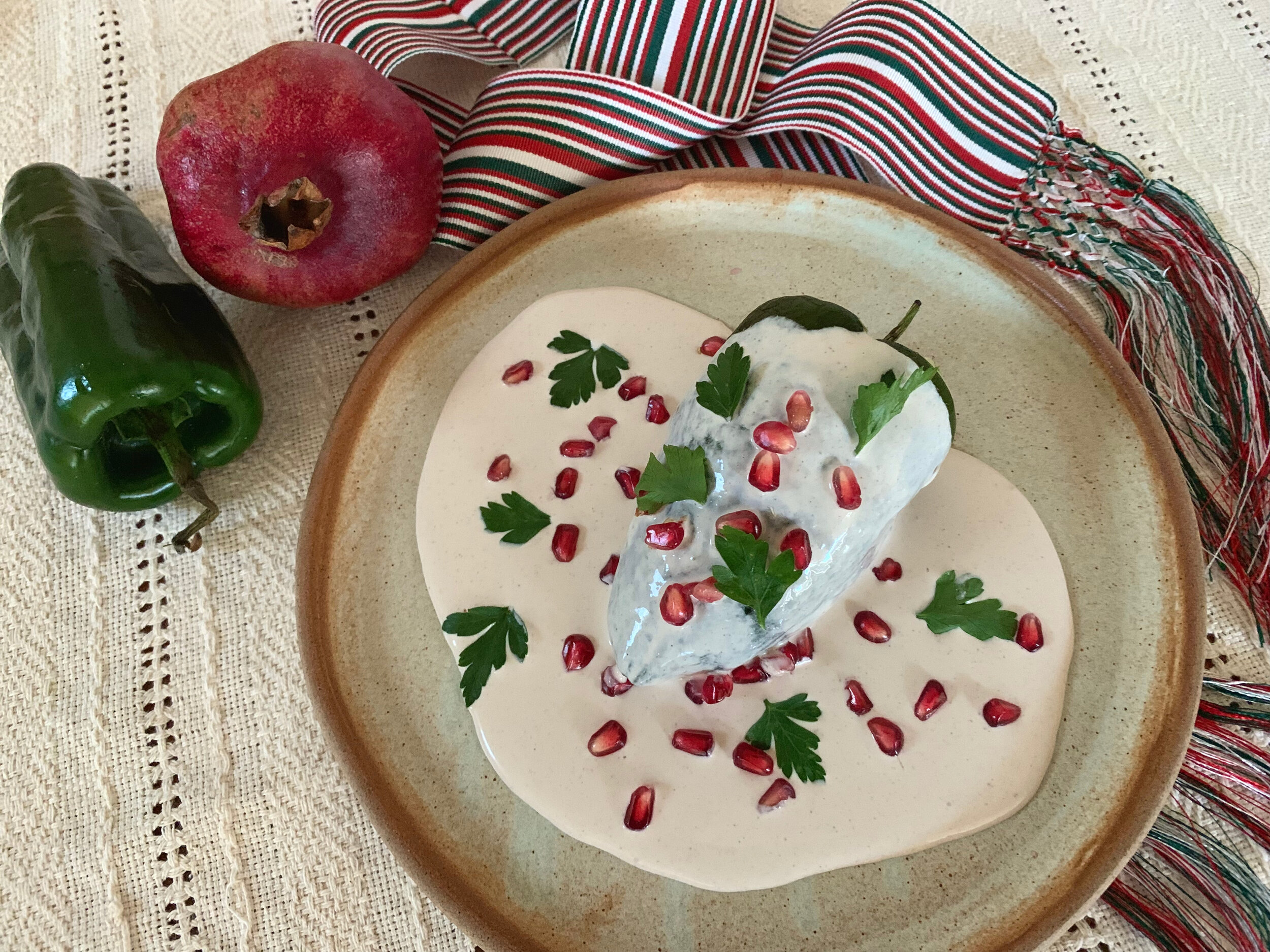If Mole Poblano is Mexico’s most famous dish, then the Chile en Nogada is its equally famous, yet evanescent, partner.
While Mole is enjoyed year round, Chiles en Nogada make an appearance towards the end of August for two important reasons. First: to make them, we need specific ingredients that become only available at harvest time, and Second: we make them to commemorate the Mexican Independence and General Agustín de Iturbide, one of our war heroes. It is believed that the recipe was invented by the nuns of the Convent of Santa Mónica in Puebla in September 16, 1821, the year the war ended and Independence from Spain was achieved.
To make these stuffed poblano chiles, we need specific seasonal ingredients like apples, pears and peaches - the original and most traditional hail from the region of Calpan, in the State of Puebla. The apples are called Manzanas Panocheras, the pears are called Peras de San Juan, both very firm and sweet, and the peaches are called Duraznos Amarillos, these are firm, not soft like our northern peaches. The crowing glory of these chiles is the walnut cream sauce that covers them. Made with Nuez de Castilla, these walnuts are picked fresh and then blanched and peeled, and they make the creamiest, whitest sauce - simply delicious! Last, but not least, the poblano chile, named for the State of Puebla. These fruits are the special ingredients that are part of the meat mixture, along with almonds, raisins, tomatoes and canela. It is a slightly sweet and savoury filling for these special chiles.
Now, let’s talk about the Nogada, shall we? Nogada translates to “nut sauce”, or “full of nuts”. The original recipe is made with a fresh cheese that I don’t have available in Canada, so my recipe uses a mixture of goat cheese, cream and milk, along with walnuts, blanched almonds, a bit of sugar and salt. I also like to add a touch of Oloroso sherry to give it that sophisticated taste. The sauce is blended until completely smooth and that is that!
The traditional garnishes are pomegranate seeds and parsley, and those colours, along with the white walnut sauce, symbolize the colours of our flag.
This recipe, a real fusion of ingredients and flavours became the work of art that us Mexicans look forward to and enjoy every year. It is a masterpiece that encompasses the flavours and techniques of both the old world and the new world, something that the nuns of the time were very skillful at - making the most of what that was available to them seasonally, geographically and culturally.
Now, I have to confess that though I am a traditional cook, I am not a lover of sweet and savoury dishes, so if I’m making these chiles for myself only, I omit the fruit in the filling. However, if I’m making these for company, I go by-the-book traditional. For me, the sauce is the best part of these chiles, and whenever I make them, I feel like licking the plate!
It is important to note that there are hundreds of recipes out there for Chiles en Nogada. It boils down to families and their own recipes, like always. I am in Canada, so I will not only add my particular tastes, but I will also substitute ingredients from what’s available to me. The same thing applies in Mexico or anywhere else you may be. The original ingredients for this recipe are available locally in Puebla - where the dish originated, but those same ingredients may not be available in other parts of the country, and that’s why we see variations of recipes, and that’s OK too. I love to learn the true origins of recipes, and then I can adapt as needed.
So without further ado, here is my recipe for these Chiles en Nogada. I hope you try them and then make them to suit your own tastes. And whenever you eat them, think of Mexico and why these chiles are so special.
Chiles en Nogada
Poblano Chiles in Walnut Sauce
Nogada:
Makes 4 cups
200g plain goat cheese, softened
1 1/4 cups heavy cream
1 1/2 cups milk
1/2 cup slivered almonds
1 1/2 cups walnuts, soaked in milk for 1 hr, then drained
3 Tbsp Oloroso Dulce sherry, or to taste
4 tsp sugar or more to taste
1 tsp kosher salt, or more to taste
Filling:
2 Tbsp vegetable oil or lard
1 kg ground pork, beef or a mixture of both
1 cup diced onion
2-3 garlic cloves
2 Roma tomatoes, diced
1 small ripe but firm pear, diced
1 small Royal Gala apple, peeled and diced
1 small ripe but firm peach, diced
1 small stick canela or cinnamon, or 1/4 tsp ground
1/4 cup slivered almonds
1/4 cup golden raisins
1 1/2 tsp kosher salt, or to taste
1/4 tsp black pepper, or to taste
8 poblano chiles
Garnish:
1 cup pomegranate arils
8 sprigs flat leaf parsley, leaves only
To make the Nogada, place softened goat cheese, cream, milk, almonds, walnuts, sherry, sugar and salt in blender container. Process until completely smooth. Adjust seasonings and reserve.
To prepare the chiles, place over an open flame on the stove, barbecue or under the broiler, turning often, until skin is blistered on all sides. Place in a large bowl and cover with a plate or plastic and let them steam for about 10 minutes. Using paper towels, gently rub charred skins off. Cut a slit down the side of each chile and carefully remove all veins and seeds.
To make the filling, in large pan, heat oil and cook meat, breaking it up as you go, until no longer pink. Add onions and cook until soft, then add garlic and tomato and cook until tomatoes are soft, about 5 minutes.
Add pears, apples and peaches and cinnamon and cook only until fruit softens a bit. We don’t want fruit to fall apart. Add almonds, raisins and salt and pepper to taste.
Fill each poblano chile with stuffing, but try not to over-stuff. Once full, it should retain its original shape and be able to close.
These chiles are best served slightly warm or at room temperature.
To serve, place one chile per plate, cut side slightly to the side - not directly on top, so that the top of the chile appears smooth. Spoon walnut sauce over each chile and garnish with pomegranate and parsley leaves.
Enjoy!
Makes 8.


